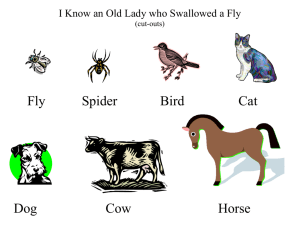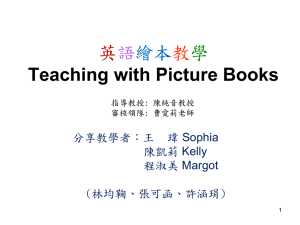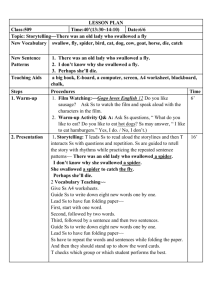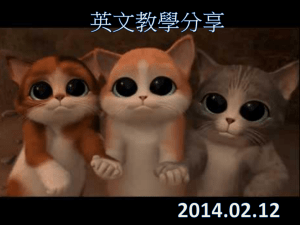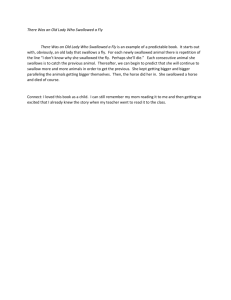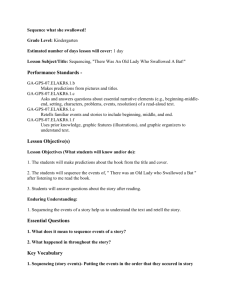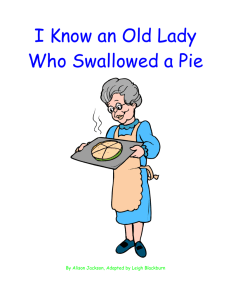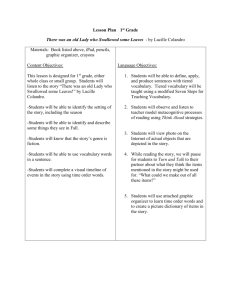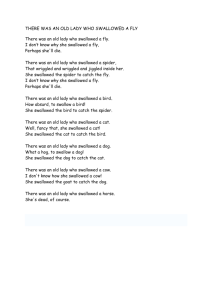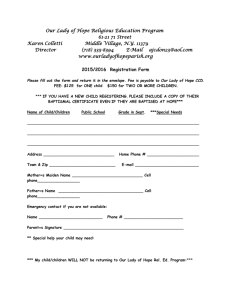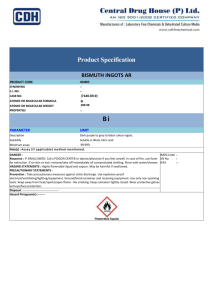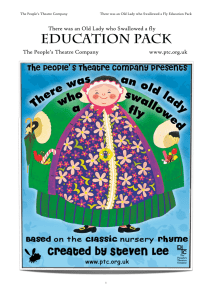Lesson Plan Based on Instructional Design
advertisement
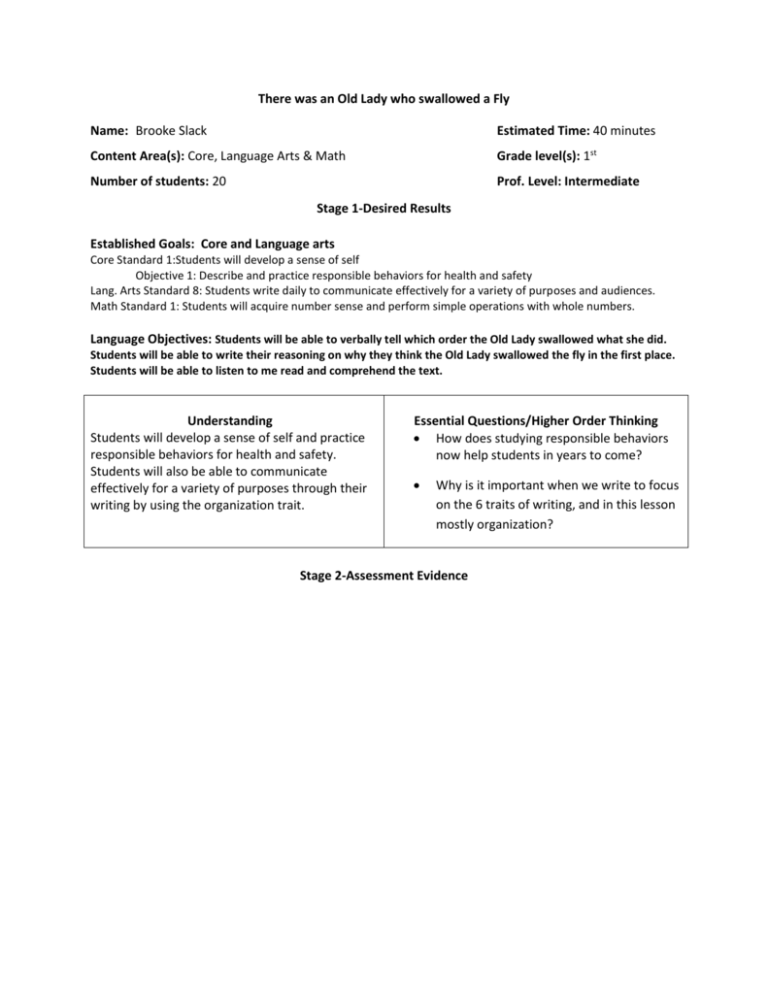
There was an Old Lady who swallowed a Fly Name: Brooke Slack Estimated Time: 40 minutes Content Area(s): Core, Language Arts & Math Grade level(s): 1st Number of students: 20 Prof. Level: Intermediate Stage 1-Desired Results Established Goals: Core and Language arts Core Standard 1:Students will develop a sense of self Objective 1: Describe and practice responsible behaviors for health and safety Lang. Arts Standard 8: Students write daily to communicate effectively for a variety of purposes and audiences. Math Standard 1: Students will acquire number sense and perform simple operations with whole numbers. Language Objectives: Students will be able to verbally tell which order the Old Lady swallowed what she did. Students will be able to write their reasoning on why they think the Old Lady swallowed the fly in the first place. Students will be able to listen to me read and comprehend the text. Understanding Students will develop a sense of self and practice responsible behaviors for health and safety. Students will also be able to communicate effectively for a variety of purposes through their writing by using the organization trait. Essential Questions/Higher Order Thinking How does studying responsible behaviors now help students in years to come? Why is it important when we write to focus on the 6 traits of writing, and in this lesson mostly organization? Stage 2-Assessment Evidence Objectives Students will be able to: 1. Develop a sense of self and the importance of health and safety. Learning Analysis Pre-Assessment of Prior Knowledge No ELL students 1. As a class students will organize the sequence of events from the book. 1 Legally blind student (with an aid), 1 student with autism, 1 student with cerebral palsy (not always present in the classroom) 2. Write a short paragraph of why they think the Old Lady swallowed the fly in the first place. 2. Differentiate between foods that are healthy or unhealthy for our bodies. 3. Apply what they learn in this lesson to their everyday lives. 4. Compose why they think the Old Lady swallowed the fly and follow the organization trait. Procedures Assessments Formative and Summative Ability Levels: There are high students, middle students, and low students. There is quite a variety of ability levels. Students are aware of group work procedures. Students enjoy making class books out of their writing assignments. Stage 3-Learning Plan Time Materials Resources 3. Participation and following of class rules and procedures. 4. I will be assessing through out the whole lesson whether it is by observation, participation. 5. The writing prompt. Differentiation (i.e., student diversity) 1. This is not the first lesson from this topic. We have previously covered the sequences, and other items from the book. Book 5 min Book 2. Go over key vocabulary with the students: swallowed, sequence, healthy, unhealthy, and responsible. 3. Take a book walk of “There was an Old Lady who swallowed a fly” by Simms Taback 5 min None Doing hands on projects motivates students. Picture Sorts None Students will be allotted adequate wait time depending on the questions and ability levels. Writing prompt paper Special needs students will be allotted more time to finish up the project at another time. 5 min 10 min 4. Read the book as a class. 5. Discuss why the Old Lady swallowed the living things in the order that she did. What did she eat first? Next? Last? 6. We will sort the animal cards that the Old Lady swallowed in sequence on the board. (1st, 2nd, 3rd, 4th, 5th, 6th…) 7. Ask the students why they thought she swallowed the fly in the first place. Brainstorm some ideas together. 8. Discuss the writing prompt, and put the students to work. Remind students to organize their ideas before they write them. 9. Create a class book with the writing prompts and read them aloud to the class. 10. Before the lesson try to link to the students background. Ask the students if they have eaten anything that was unusual or weird to others. Do you know what it is like to be in 1st place, or in 3rd place? Think about our last math lesson. Do you remember when we ordered kids in the class from 1st to last? As we are covering key vocabulary I will allow students to work with partners or an aide if they need key concepts clarified. 5 min 10 min Many visuals and hands on materials Students are seated in mixed ability levels. We will work as a whole group, with partners, and individually. If there were ESL students in my classroom I would make sure that I had enough visuals, and possibly a few vocabulary words that have been translated. I will use a slow rate of speech, make sure to enunciate my words, and use directions that will be easy for the students in my class to understand. I will model the writing prompt for the students. 11. For interaction and discussion between teacher/student and among students we will be sharing our ideas of the Old Lady swallowed the fly with their shoulder partners then share with the class and teacher. We will also be working as a class to put the items in the order that she ate them. The teacher will give regular feedback during the lesson and at the end of the lesson. 12. Reading the book, listening to the book, talking about the reasoning and explaining the order, and writing why they think the Old Lady swallowed the fly. 13. Make sure throughout the lesson the key vocabulary is covered. Then, cover the key vocabulary at the end of the lesson: swallowed, sequence, healthy, unhealthy, and responsible. 14. Review the key concepts: Students will be able to verbally tell which order the Old Lady swallowed what she did. Students will be able to write their reasoning on why they think the Old Lady swallowed the fly in the first place. Students will be able to listen to me read and comprehend the text. This will be done between the teacher and the student. Extensions: This lesson will span over about 3-4 weeks. During the week the students will have the opportunity to do extension activities. One of the centers that will be set up is part of the food guide pyramid and the students create grocery lists containing food that would help them practice healthy, responsible behaviors. There will be math activities, and many more opportunities for the students to learn about responsible, healthy behaviors. Plans for involving parents or families: The students could help prepare grocery list from what they have learned is good for their bodies. They could also help cook meals and learn about serving sizes. Reflection:
